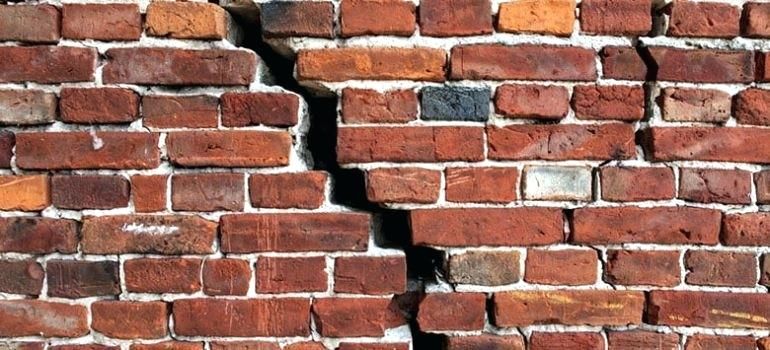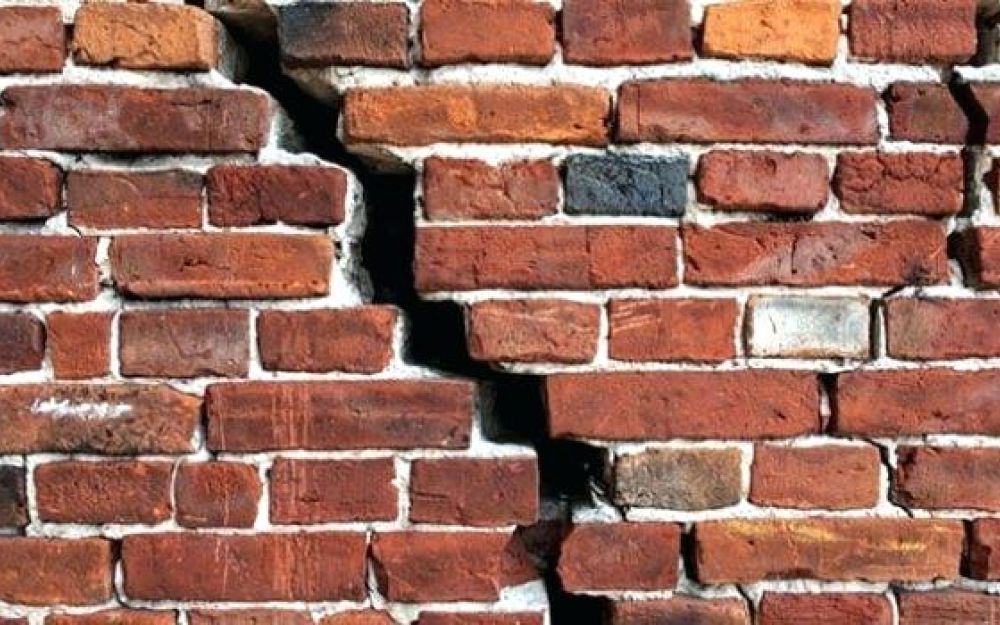Should I Be Worried About Cracks in Brickwork?



Cracks in Brickwork – Causes, Types & Repairs
A house foundation provides the stable base needed to handle the sheer load from the walls, floor, and roof. Many homes throughout Virginia and Northeastern North Carolina may have brick foundations, walls, and/or chimneys. Brick materials undergo a range of problems that may lead to cracks, chips, and shifting. If you have discovered a crack running along the interior or exterior of the home, you may be wondering, “Should I worry about cracks in my brickwork?”
Cracks in bricks may allow water to enter the materials, resulting in further deterioration. The water may also cause the cracks to worsen when it freezes and thaws as the water contracts and expands based on the temperatures. Any brick along your home, whether on walls, steps, foundations, or chimneys, may experience this serious problem. However, the problem for cracked bricks found along the upper parts of the house may lie with the foundation.
When the foundation experiences an issue, it may settle and shift. When this happens, the moving foundation may cause cracks in the brickwork as well as sagging drywall and uneven floors. A foundation problem may also cause the doors on cabinets and rooms to swing open or shut on their own. The structural stability of your home becomes compromised and may eventually lead to a collapse.
The moment you notice cracks in your Hampton Roads brick home, you should get foundation repair. BAY Crawl Space & Foundation Repair helps homeowners discover whether the cracks in brickwork may come from foundation issues. We offer a free estimate to assess the issue and then provide cost-effective solutions to make your foundation stable and safe for your entire home.
Are Cracks in Bricks Normal?
No. Brick and other masonry work are designed to last for many generations. While the mortar between the bricks may wear away from age and weather, cracked bricks are not a normal occurrence for Virginia and Northeastern North Carolina homes. You should always investigate even the smallest cracks, as they could be the first indicator of a sinking foundation or serious structural damage to building supports.
How Do You Know if a Wall Crack is Serious?
Think of wall cracks as your home telling you that there is a problem. They may be the most visible sign that there may be foundation failure. The reason that the foundation or building supports are failing may be difficult to discover and could come from a variety of sources. Having the professionals at BAY Crawl Space & Foundation Repair evaluate the foundation and your home may help to discover the possible issues.
Our inspectors provide a free estimate as they evaluate several aspects of your home including the metal lintels over windows and doors, the foundation, the crack’s pattern, and the soil around the foundation. We may also ask specific questions regarding other issues that you may have noticed inside your home such as leaning floors or doors that will not stay shut.
What Causes Cracks in Brickwork in Virginia Homes?
The causes for brickwork cracks may vary. Your home may also experience more than one issue that is impacting the building supports or foundation. We have gathered a list of the most common issues.
Climate and Seasonal Changes
Hampton Roads homes experience a wide fluctuating range of temperatures throughout the year. Homes also go through various climate changes, including severe thunderstorms, blizzards, hail, baking heat, and even hurricanes. With the temperatures and weather rolling over the area, the house materials expand and contract due to the temperatures, moisture, and humidity. This constant expansion and contraction movement may create cracks along the brick that you may see along the home’s corners.
In addition, the mortar and grout used between the bricks consist of concrete. Concrete is porous. It absorbs moisture as it expands in the summer during warm weather and then contracts in the winter. Mortar cracks form that may shift and loosen the bricks.
Settlement
Footers run along the home‘s foundation walls as they are designed to handle the house’s load. They prevent the home from settling, although most homes do settle a little bit over time, such as 1/4 inch in over 20 years. Excessive settlement may indicate something going on underneath the house, such as poorly designed footers, loose/weak soil, excessive corrosion, or other factors.
Too Much Load
All of the soil compacted around the foundation and walls of the home has enormous amounts of load force. When designed correctly, the foundation ensures that the load stays in place. Unfortunately, the walls of the home may buckle because of too much load. If the load force is more than the walls can handle, buckling occurs as the walls sag or lean inward. Foundation cracks may also occur when too much weight becomes placed onto the walls of the home.
Soil Condition
Even the condition of the soil may negatively impact the brickwork. Soil that is too porous, not compacted, or overly saturated with water may allow the foundation to shift and make brickwork cracks. The soil may wash away due to water from misdirected downspouts, gutters, leaking pipes, and standing pools of water along the perimeter of the home. Sub-surface water could wash away the soil located around the footings. Another factor that leads to soil problems may involve moist soil drying out and shrinking.
Deterioration/Age of Building Materials
Building materials have a set lifespan. For extremely old homes, the age of the house may cause the materials to slowly deteriorate. In time, walls sag, and the mortar loosens to cause brick cracks. Also, the constantly long years of exposure to the elements detrimentally impact the condition of the building materials.
Tree Roots Close to the House
Planting trees may allow you to provide shade to certain areas of the yard. However, the tree roots can grow very long, wide, and deep. These roots could cause a structural problem to the foundation of the home and cause the foundation and walls to buckle upward.
Another factor involves the roots pushing the soil away as they make room to grow. If the tree dies or becomes removed, the roots may deteriorate as the soil collapses into the empty spaces. This subsidence can cause the foundation to settle and shift.
What Do Different Types of Cracks Mean?
Cracks along the brickwork of your Virginia or Northeastern North Carolina home hold different meanings based on their patterns. Not only could the cracks vary in size, but also in direction, location, and appearance. Understanding the different types of cracks may help you to identify what types of issues are happening with your home.
- Diagonal/Stairstep Cracks: Diagonal or stair-step brick cracks usually run along the brick’s exterior walls as they may indicate foundation movements as the bricks separate from the mortar.
- Horizontal Cracks: These types of cracks are formed when the soil pushes against the foundation and causes the walls to bow inward. These horizontal brick cracks can indicate serious foundation failure.
- Vertical Cracks: Vertical cracks are early warning signals that something may be going on with the foundation. They could indicate a change in soil conditions that causes foundation shifting.
- Spalling: Spalling is a condition where the concrete or brick material flakes away. This flaking could be caused by excessive moisture, corrosion, or weathering, as it is a dangerous indicator that the foundation is crumbling away.
How Do I Repair Cracks in Brickwork?
Repairing cracked brick walls depends on the root causes of the failure and the extent of the underlying damage. Here are several ways to fix cracks.
Replace Damaged Bricks
If only one or two bricks show cracks, it could simply be that the bricks were defective or deteriorated faster. You can remove the old grout and take out the split or cracked brick. Then, place in new mortar and brick.
Repointing/Tuckpointing
Repointing and tuckpointing are two methods for repairing and finishing the mortar. After the foundation issue has been repaired, you can perform repointing to remove the damage and fill the mortar joints back in. Then, tuckpointing is performed by applying lime putty or fine lime mortar on top.
Rebuilding
For some circumstances, such as bowed or sagging brickwork, the entire wall may need to be replaced. It is always advisable to diagnose the cause of the issue before rebuilding to avoid replacing the wall again in the near future.
Can I Repair Damaged Brickwork Myself?
It is plausible to perform some of the smaller and easily repairable tasks yourself, such as cosmetic cracks or hairline cracks. You are able to control material and labor costs while restoring the brickwork to its original state for the DIY project.
Yet keep in mind that serious cracks could cause safety hazards when you start pulling out bricks and chipping away the mortar. The likelihood of structural wall collapse is a possibility depending on how deteriorated or unstable the brickwork is, and you may also damage foundations if performing foundation work by yourself.
Calling a professional allows you to tap into their extensive knowledge and experience to get the work done correctly. While it costs more upfront to hire a professional, it is the better long-term option to avoid having to perform the work again if it is done incorrectly.
Don’t Let Cracks Worsen. Call Us for Immediate Solutions
Never let brickwork cracks ruin your Hampton Roads home. Find out the cause of the cracks and get your foundation repaired by our contractors today. To speak with one of the foundation experts at BAY Crawl Space & Foundation Repair, call 757-460-0444 or complete the online contact form, and we’ll be in touch!

